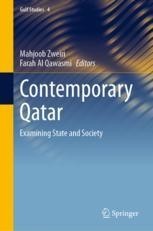Edited books are challenging to summarize, this post surveys some of the chapters and key points that stood out to me in this new collection, Contemporary Qatar (2021), edited by Zweiri and Al Qawasmi.
Ch 1 outlines the challenges experienced by the new state, often driven by external actors but which slowed the process of state building, which included the oil embargo (1973/4), oil crisis (1979), Iranian revolution (1979), Egypt-Israel peace treaty (1979), Iran-Iraq war (1980-88), GCC (1981), invasion of Kuwait, Gulf War (1990/1), Soviet collapse (1991), Jordan-Israel peace treaty (1994), failed coup (1996). The resources that Qatar holds today, largely LNG, were not a certain investment in the 1990s, when prices were low, but paid off in the long run. LNG development began in 1991, with the first export in 1997, the economic benefits of this enabled economic diversification in the 2000s, and beyond. The authors also note the niche areas of diplomacy that develop: (1) peace diplomacy / conflict resolution in Yemen, Sudan, Palestine, Syria, Afghanistan, Lebanon, Eritrea; (2) higher education, with Education City, (3) Media with Al Jazeera Media Network from 1996, and (4) Sport via 2008 Asian Games, 2011 Pan Arab Games, to FIFA and beyond.
Ch 2 is historical, and there are several book length efforts on this. I'll leave the summary as I have done that for the other books. Ch 3 on governance highlights unique directions of Qatar for the region, and what consequences this had - namely supporting a generation of young leaders and expanding freedoms, which created some tensions in the region with other nations whose leaders did not share this vision. Ch 4 covers political participation - there is much said about the 2021 elections, but municipal elections have been on-going since 1999; the author shows a relatively low voter registration, variable voter turn out, and declining candidates. This chapter is quite quantitative. There appears to be a need to delve into the qualitative aspects of why.
Ch 5 covers foreign policy (also covered by Kamrava, I'll avoid repetition here). Ch 6 explores the peace diplomacy, drawing on first hand experiences, and outlines the cases of Yemen, Lebanon, Sudan, Djibouti, Palestine, and Afghanistan. Some unique contributions in this chapter for those interested. Ch 7 offers a detailed case study on foreign relations with Palestine while Ch 8 outlines the expansion of military capacity and capability following the 2017 blockade of Qatar. Ch 9 broadens the conversation on sport in Qatar, moving beyond its international and tourism purposes, but also its cultural and bottom-up social drivers. Ch 10 re-orients the rentier framing of Qatar to one in the political realm, as a developmental state; this seems a useful re-conceptualization, as far too often broad generalizations are made of groups of states, which may not hold. Ch 11 covers the geopolitical of gas, specifically in relation to the US shale gas market and Qatar's LNG.
Ch 12 is one of the few in this collection that address domestic social issues, it focusing on national identity. The drivers resonate with many other chapters (economic, education, big projects, blockade), what is unique about this chapter is that the author presents recommendations on how the emerging national identity issues could be address, which include: (1) cultural criteria for immigrants (in a country where the majority are not citizens); (2) a labour market shift that focuses upon the longer term / multi-generational migrants who are 'local' as opposed to revolving shifts of foreign workers; (3) strengthen public schools via state investment and training with an aim to increase their appeal and phase out coupon system currently in place for private schools; (4) ensure the urban housing policy facilitates residential structures that are intentionally mixed, slowly addressing the legacy of some families living in particular areas to enable greater interaction and solidarity across society. Ch 13 addresses the memory of the blockade, and makes an interesting case about the rise of nationalist sentiment before the blockade that enabled the government to take a bold stance, which thereafter increased nationalist sentiments. Ch 14 covers women in the workforce, with Qatar being positioned as having a low female work force participation and lacking a 'female friendly' work environment. However, the chapter would have been enhanced with regional and international comparisons - Qatar has relatively high female labour force participation (similar to Germany and the UK) and has a rate nearly triple that of other regional countries (e.g. Saudi, Egypt, Iran). The interesting question seems to be the converse - what enabled Qatar to be so different (while acknowledging that further progress could yet be made on enable greater labour participation).
This is an excellent collection of works for those interested in Qatar. A limitation is that a lot focuses on the political and economic realms (domestic and international) and less on the social issues (other than national identity and female labour participation). Nonetheless, for those interested in the subject areas covered, this is an important contribution.

